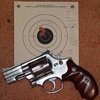PhillySoldier
Member
- Joined
- Sep 11, 2017
- Messages
- 150
Wondering what testing methods people use for pistol load development?
Previously I would start loading in 0.2 increments from mid range to a little below max published data. I would make 5 rounds of each and fire over a chrono looking to what got me closest to a 130 power factor. Im not a competitor but figured this is what is most used by minor competitors for accuracy with the lightest recoil.
Recently though I have started testing with a ransom rest and shooting 10 rnd groups @ 25 yards. The results were disappointing and really proved to me just how bad my reloads were. On a good note though was finding out that what I previously thought of as my limitations was more a matter of my ammo choices. This has definitely changed up my load development. Now Im more goal orientated to find what is most accurate.
My testing has changed and continues to change as I find ways to improve. For each rung testing I’ll shoot two groups of 10 rounds from the ransom rest and record the group sizes as well as the velocity results. I’ll compare the results to see what groups the best across a few 0.1 increments.
My older testing was much smaller in rnds per group as well as larger increments between rungs. It’s a more of a hassle now though to drag out so much gear and an hour to get setup and ready. So now Im loading everything, 20 rnds of each 0.1 increment from a little above low to max. I loaded up 300 rnds for my next test. 20 rnds each of 15 different increments. I figure I’ll test shoot in 0.2/0.3 increments till the results narrow that down a bit to whats working best and I can further test from there. Definitely overkill but Id rather just get the testing done in as little trips as possible. Left over ammo I’ll re-designate to plinking rounds.
Any advice, suggestions, criticisms are welcome. And also interested in testing methods used by other members. If it needs to be said; my goals are finding out loads are most mechanically accurate out of each of my pistols. I put it this way to “hopefully” head off any debates on shooters skills vs mechanically accuracy.
Previously I would start loading in 0.2 increments from mid range to a little below max published data. I would make 5 rounds of each and fire over a chrono looking to what got me closest to a 130 power factor. Im not a competitor but figured this is what is most used by minor competitors for accuracy with the lightest recoil.
Recently though I have started testing with a ransom rest and shooting 10 rnd groups @ 25 yards. The results were disappointing and really proved to me just how bad my reloads were. On a good note though was finding out that what I previously thought of as my limitations was more a matter of my ammo choices. This has definitely changed up my load development. Now Im more goal orientated to find what is most accurate.
My testing has changed and continues to change as I find ways to improve. For each rung testing I’ll shoot two groups of 10 rounds from the ransom rest and record the group sizes as well as the velocity results. I’ll compare the results to see what groups the best across a few 0.1 increments.
My older testing was much smaller in rnds per group as well as larger increments between rungs. It’s a more of a hassle now though to drag out so much gear and an hour to get setup and ready. So now Im loading everything, 20 rnds of each 0.1 increment from a little above low to max. I loaded up 300 rnds for my next test. 20 rnds each of 15 different increments. I figure I’ll test shoot in 0.2/0.3 increments till the results narrow that down a bit to whats working best and I can further test from there. Definitely overkill but Id rather just get the testing done in as little trips as possible. Left over ammo I’ll re-designate to plinking rounds.
Any advice, suggestions, criticisms are welcome. And also interested in testing methods used by other members. If it needs to be said; my goals are finding out loads are most mechanically accurate out of each of my pistols. I put it this way to “hopefully” head off any debates on shooters skills vs mechanically accuracy.












